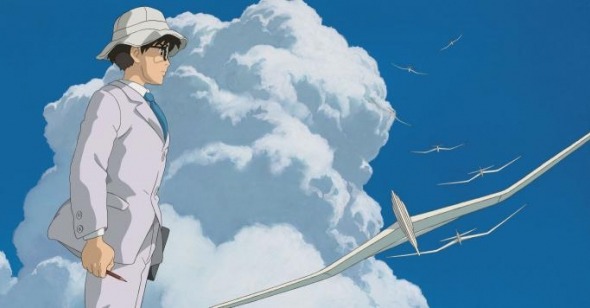All Float On
By Fernando F. Croce
The Wind Rises
Dir: Hayao Miyazaki, Japan, Touchstone Pictures
In the oneiric opening sequence of Hayao Miyazaki’s gorgeous animated drama The Wind Rises, a boy climbs to the roof of his house to gaze at the stars and finds a small flying contraption waiting for him. He leaps in without a moment’s hesitation and takes off, happily zipping through the air until the skies above him suddenly grow dark with dirigible bombers. The child’s simple and delighted acceptance of the fantastic, as well as the way the joyous scene turns abruptly ominous, is crystalline Miyazaki. The rest of the film remains firmly situated in the adult world, yet The Wind Rises never loses the guileless spark of this early passage, even as its protagonist comes to grapple with increasingly grave issues. It’s the inspired and contemplative work of a septuagenarian artist who still sees with the eyes of a youthful dreamer.
The pubescent wannabe aviator is Jiro Horikoshi, a real-life figure best known as the designer of the Mitsubishi A6M Zero fighter. At the beginning of The Wind Rises, however, he’s still a boy who enhances his airborne reveries by reading English aviation magazines, translating each word with a dictionary while marveling through thick glasses at the pictures of aeronautical machines. When next seen years later, Jiro (voiced by Hideaki Anno) is on his way to Tokyo for his studies. His round specs, boater hat, and gangling demeanor suggest one of Harold Lloyd’s Jazz Age go-getters, though what follows swiftly, startlingly places him in a specifically Japanese time and place. The cataclysmic 1923 Kanto Earthquake derails his train, and the shattered buildings and devastating firestorms lining the horizon give Jiro a dismaying view of the shocks the world is capable of outside the cozy bubble of his pastoral childhood. Facing natural disasters, heavy exodus from rural to urban areas, and an abysmal economy, Japan is at a time of forced modernization, depending on the young to catch up with more technologically advanced Western powers. And, as its imperialist sentiments intensify, the government begins to look at the military potential of the aviation industry.
Unable to actually pilot planes due to his weak sight, Jiro channels his enchantment with flight into progressive aerial designs at his company. In his dreams, he’s visited by one of his early heroes, pioneering Italian engineer Giovanni Caproni (Mansai Nomura), who takes the younger man into the belly of one of his gargantuan inventions and asks, “What would you choose? A world with pyramids, or one without?” In the real world, however, Jiro—a meek whiz-kid far from, say, the bedeviled Icarus of Martin Scorsese’s The Aviator—hardly entertains such monumental queries. Buoyed by his pursuit of beauty, he barely notices the surge of history around him. Sent to Berlin to negotiate industrial innovations with the Germans, he witnesses a man being chased by uniformed brutes but shrugs and moves on. Does it ever cross his mind that the metallic creatures he so lovingly works on might be put to destructive use? The protagonist’s naiveté is pricked at a vacation resort in Karuizawa, where a German expatriate, paraphrasing Thomas Mann, caustically extols the bucolic site as “a nice place to forget” Japan’s aggressions, such as the recent invasion of Manchuria. It’s also there that Jiro crosses paths with Naoko (Miori Takimoto), the spirited, ailing artist he will love and, inevitably, lose.
The Wind Rises takes its title from the Paul Valéry poem Le Cimetière Marin: “The wind rises! We must try to live!” Natural elements often manifest themselves as life forces in Miyazaki’s films, and here the wind is practically a separate character, bringing Jiro and Naoko together by blowing away their hats and parasols, only to later symbolize the couple’s tender fragility as specks fly and clouds dissipate in a vast field. War to the avowed pacifist Miyazaki is as much of an obscene intrusion into Nature as it is to Rousseau or Malick, and yet here WWII remains a structuring absence, glimpsed in images such as a graveyard of airplanes or the heroine’s tubercular blood dripping onto her canvas. Military officers are lampooned—rushing from meetings with the Army to the Navy, the protagonist meets a veritable menagerie of Blimpish fogies and barking ramrods—but, as always, the director rejects simplistic villainy. (Even the grouchy company supervisor, with his hilariously oversized noggin, chokes back tears in the midst of Jiro’s impromptu wedding to Naoko.) Rather than a furious critique, the film gently offers the central conundrum of an inventor who is enough of a visionary to connect the shape of a mackerel bone to the curved wing of his pet project, but not wise enough to learn that his plane will be used to bomb Pearl Harbor. It’s no coincidence that, in this portrait of an artist both spiritually aloft and myopically earthbound, the dominating colors are celestial blues and verdant greens.
If The Wind Rises resembles Hollywood biopics like William Wellman’s Gallant Journey or John Ford’s The Long Gray Line in its decade-spanning structure and bittersweet tone, it is a singular showcase for the animation Miyazaki developed and perfected at Studio Ghibli. While the drawings scarcely bend the laws of physics, as in the more fanciful visions of Porco Rosso, My Neighbor Totoro, or Spirited Away, their detailed, soft-cell beauty—the swaying of Caproni’s mustache, the light emanating from a bobbing lantern—still staggers. (How refreshing to feel the handmade quality of Ghibli’s lines and patches of color, a sharp contrast to the titanium-rigid exactitude favored by Pixar.) With its introspective emphasis on personal loss and the intersection between creative art and commercialized craftsmanship, The Wind Rises certainly feels like a final work, a grand summation of many recurring themes and images. Despite the veteran animator’s announcement of retirement, this Miyazaki aficionado hopes it won’t be his last. The serene yet overflowing sensibility palpable in every frame here suggests an artist with a few more masterpieces still shimmering within him.
